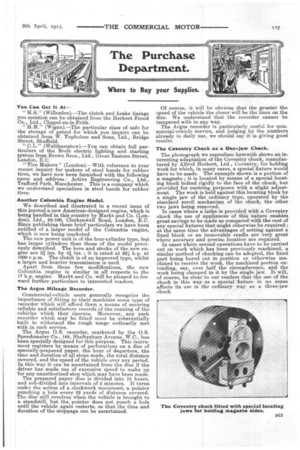You Can Get It At " M.S." (Willesden).—The clutch and
Page 17

If you've noticed an error in this article please click here to report it so we can fix it.
brake linings you mention can be obtained from the Herbert Frood Co., Ltd., Chapel-en-le-Frith.
" H.H." (Wigan).—The particular class of safe for the storage of petrol for which you inquire can be obtained from W. Tupholme and Sons, Ltd., Bridge Street, Sheffield.
"CL." (Walthamstow).—You can obtain full particulars of the Brolt electric lighting and starting system from Brown Bros., Ltd., Great Eastern Street, London, RC.
"Tire Makers" (London).—With reference to your recent inquiry for makers of steel bands for rubber tires, we have now been furnished with the following name and .addreas : Active Engineering Co., Ltd., Trafford Park, Manchester. This is a company which we understand specializes in steel bands for rubber tires.
Another Columbia Engine Model.
We described and illustrated in a recent issue of this journal a new American-designed engine, which is being handled in this country by Markt and Co. (London), Ltd., 98-100, Clerkenwell Road, London, E.C. Since publishing these brief particulars we have been notified of a larger model of the Columbia engine, which is now being marketed. The new power unit is of the four-cylinder type, but has larger cylinders than those of the model previously described. The bore and stroke of the new engine are 3i ins. by 41 ; it is rated at 22 h.p. at 1000 r.p.m. The clutch is of an improved type, whilst a larger and heavier transmission is used.
Apart from these few modifications, the new Columbia engine is similar in all respects to the 17 h.p. engine. Markt and Co. will be pleased to forward further particulars to interested readers.
The Argus Mileage Recorder.
Commercial-vehicle users generally recognize the importance of fitting to their machines some type of recorder which will afford them a means of securing reliable and satisfactory records of the running of the vehicles which they operate. Moreover, any such recorder which may be fitted must be substantially built to withstand the rough usage ordinarily met with in such service.
The Argus 0.5. recorder, marketed by the 0.8. Speedometer Co., 188, Shaftesbury Avenue, W. C., has been specially designed for this purpose. This instrument registers by means of perforations on a disc of specially-prepared paper, the hour of departure, the time and duration of all stops made, the total distance covered, and the speed of the vehicle over any period. In this way it can be ascertained from the disc if the driver has made use of excessive speed to make up for any unauthorized stop which may have been made. The prepared paper disc is divided into 15 hours, and sub-divided into intervals of 5 minutes. It turns under the action of a clockwork movement, a pointer punching a hole every 22 yards of distance covered. The disc still revolves when the vehicle is brought to a standstill, but the pointer does not punch a hole until the vehicle again restarts, so that the time and duration of the stoppage can be ascertained. Of course, it will be obvious that the greater the speed of the vehicle the closer will be the lines on the disc. We understand that the recorder cannot be tampered with in any way. The Argus recorder is particularly useful for commercial-vehicle service, and judging by the numbers already in daily use, we should say it is giving good results.
The Coventry Chuck as a One-jaw Chuck.
The photograph we reproduce herewith shows an interesting adaptation of the Coventry chuck, manufactured by Alfred Herbert, Ltd., Coventry, for holding work for which, in many cases, a special fixture would have to be made. The example shown is a portion of a magneto ; it is located by means of a special locating block bolted rigidly to the face of the chuck, but provided for centring purposes with a slight adjustment. The work is held against this locating block by a single jaw of the ordinary type, operated by the standard scroll mechanism of the chuck, the other two jaws being removed. In cases where a lathe is provided with a Coventry chuck the use of appliances of this nature enables great savings to be made as compared with the cost of any special fixtures that might otherwise be required ; at the same time the advantages of setting against a fixed block or an immovable cradle are very great where accuracy and precise location are required. In cases where second operations have to be carried out on work which has been previously machined, a similar method of chucking can be adopted, the fixed part being bored out in position or otherwise machined to receive the work, the machined portion extending, say, over half the circumference, and the work being clamped in it by the single jaw. It will, of course, be clear to our readers that the use of the chuck in this way as a special fixture in no sense affects its use in the ordinary way as a three-jaw chuck.




















